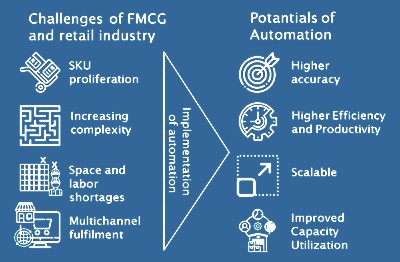Wissenschaftlicher Newsticker April 2021
Tackling FMCG and Retail Industry Challenges with Automated Solutions
Changing Consumer Expectations
FMCG and the retail industry are facing a tremendous shift toward e-commerce. The ongoing Covid-19 pandemic has caused e-commerce to grow and multi-channel shopping to enter everyday life. Expectations of product availability are growing and new delivery concepts, e.g., same-day or even same-hour delivery, are becoming normal. At the same time, the number of stock keeping units (SKUs) is growing dramatically as consumer preferences changes. Consumers expect a variety of products ranging from regional to organic in different price segments from various brands. This is causing an explosion of small brands and niche products as well as ever-changing product segments. This requires retailers to stock many diverse products in their warehouses and ensure continuous availability.

Implications for Warehouse Management
The growing number of SKUs constitute a challenge to operations at warehouses and distribution centers: Smaller quantities of orders delivered frequently add complexity to handling, storing and tracing perishable goods. The Covid-19 crisis is amplifying the complexity of warehouse operations by disrupting supply chains, causing fluctuations in incoming shipments, requiring the introduction of safe distancing, and reducing the number of employees. Employees in warehouses in which manual labor is still dominant are constantly challenged by the physical as well as the cognitive workload, information processing, and item searches and identification. Long distances between shelves and aisles impede the speed of order fulfillment as well as efficiency and productivity.
Relevance of Urban Logistics
On the other hand, proximity to customers is crucial to reducing last-mile delivery costs and ensuring high responsiveness. This has spawned a rush on real estate, ideal locations, infrastructure and logistics facilities near larger urban areas. Brownfield use, revitalization of existing buildings and the implementation of vertical storage systems in so-called multi-level warehouses are gaining in importance and typify future storage capabilities. This results in smaller warehouses with increasing density that require new concepts for efficient storage and picking strategies.
Emerging Automation Capabilities
Conventional warehousing and picking approaches are often incapable of meeting the new demands for warehouse lead times for additional SKUs. Automation, on the other hand, enables retail companies with excellent capabilities to fulfill orders efficiently and boost their service level. The right mix and level of automated technology can improve storage space utilization, increase accuracy, minimize non-value-added movements, and expedite training of new or seasonal employees. In addition, modular, scalable automated technologies can provide more flexibility as business grows, higher efficiency and greater productivity in picking operations.
For more insights on the FMCG industry and automated solutions, view the Körber Master Class Series (on demand):
Julia Arlinghaus: SKU Proliferation in FMCG: How can automation help?
- April 6, 2021: The Right Storage Method for Your Warehouse
- April 13, 2021: How layer picking can mitigate the effects of SKU proliferation
- April 20, 2021: Increasing productivity of person-to-goods operations
- April 27, 2021: Improving a goods-to-person Order Fulfillment System
Contact: Julia Arlinghaus
Sources:
(1) Handelsverband Deutschland, IFH Köln 2018, Handelsreport Lebensmittel 2018– Fakten zum Lebensmitteleinzelhandel, Retrieved 19.04.2021
https://einzelhandel.de/images/HDE-Publikationen/HDE_IFH_Handelsreport_Lebensmittel_2018.pdf
(2) Aareal BankAG, 2020, Logistikimmobilien - Investieren in Assets mit Perspektive, Retrieved 19.04.2021
(3) Boer, O., Buck, R., Guggenberger, P., Simon, P., 2020, Completing a transformation in the consumer-goods industry, Retrieved 19.04.2021 https://www.mckinsey.com/industries/consumer-packaged-goods/our-insights/completing-a-transformation-in-the-consumer-goods-industry
(4) Kelly, G., Kopka, U., Küpper, J., Moulton, J., 2018, The new model for consumer goods, Retrieved 19.04.2021
(5) JLL Jones Lang LaSalle, 2020, Logistics buildings of tomorrow, Retrieved 19.04.2021
(6) Danny Green, 2018, The Challenges Faced by FMCG Supply Chain Users, Retrieved 19.04.2021
https://knowledge-leader.colliers.com/danny_green/the-challenges-faced-by-fmcg-supply-chain-users/
(7) Custodio, L., Machado, R., 2019, Flexible automated warehouse: a literature review and an innovative framework, The International Journal of Advanced Manufacturing Technology, P. 553-558, DOI:10.1007/s00170-019-04588-z
(8) Kille, C., Nehm, A.,2017, Zukunft der Logistikimmobilien und Standorte aus Nutzersicht, https://www.logix-award.de/wp-content/uploads/2018/03/Studie_Logix_Nachdruck_2018.pdf
(9) Berman, B. 2011, Strategies to reduce product proliferation, Business Horizons, 54, 551-561, DOI:10.1016/j.bushor.2011.07.003
(10) Grosse E.H., Glock C.H:, Neumann, P.W. 2015, Human Factors in Order Picking System Design: A Content Analysis, IFAC-PapersOnLine, Vol.:48, Issue: 3, P. 320-325, DOI: 10.1080/00207543.2014.919424
(11) De Koster, R. & Le-Duc, T. & Roodbergen, K.J., 2007. Design and control of warehouse order picking: a literature review. European Journal of Operational Research. Vol. 182. P. 481-501.
(12) Tomkins, J. A., White, J. A., Bozer Y. A., Tanchoco, M.A., 2010. Facilities Planning 4th edition, John Wiley & Sons Inc.
(13) Rushton, A., Croucher, P. & Baker, P., 2014. The Handbook of Logistics & Distribution Management, 5th Edition. London, Philadelphia, New Delhi: Kogan Page Limited.
Text published on ESM: https://www.esmmagazine.com/supply-chain/meeting-new-challenges-fmcg-understand-automation-capabilities-warehouse-management-126495






